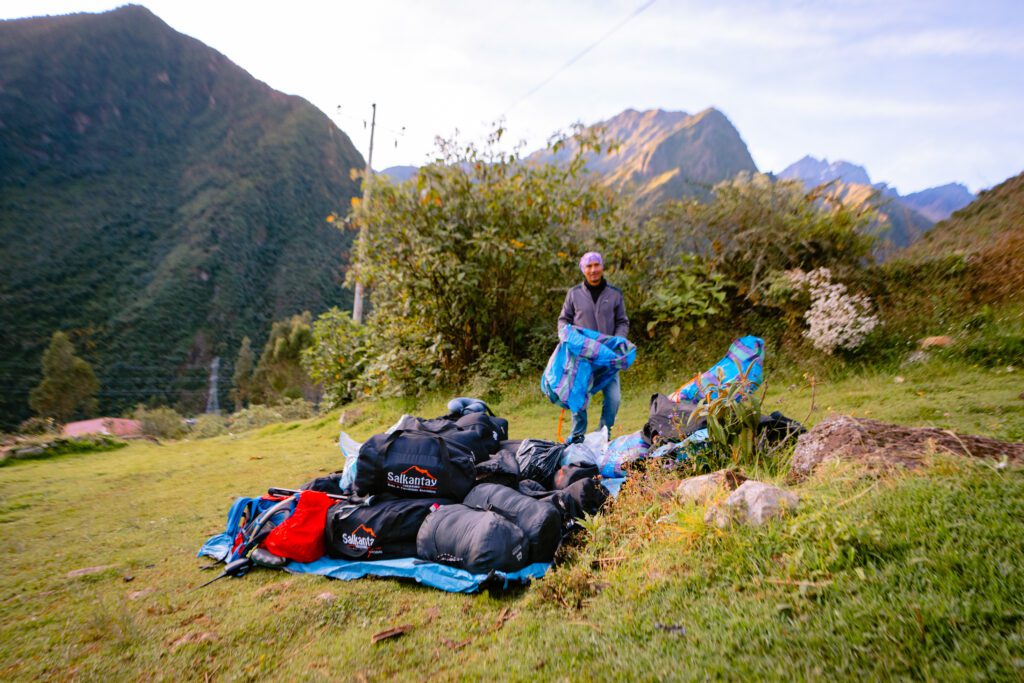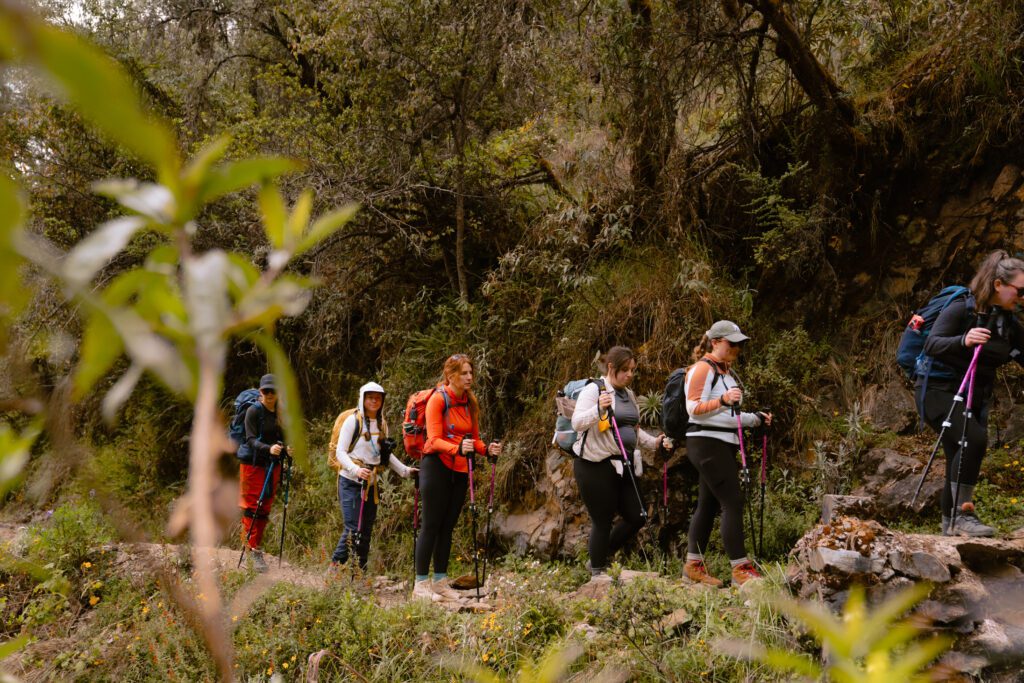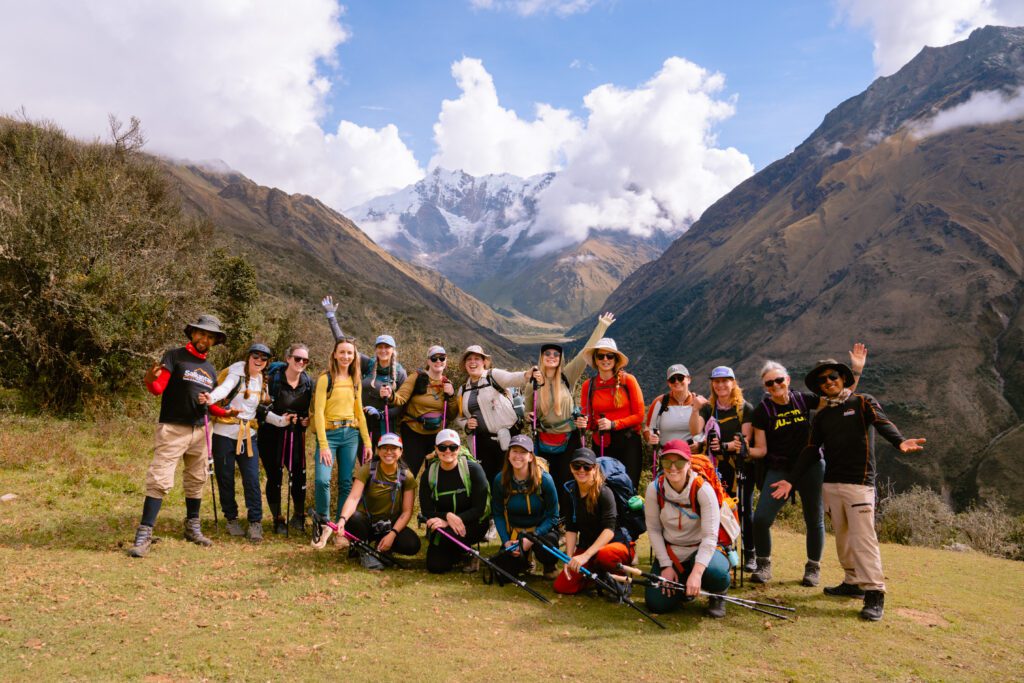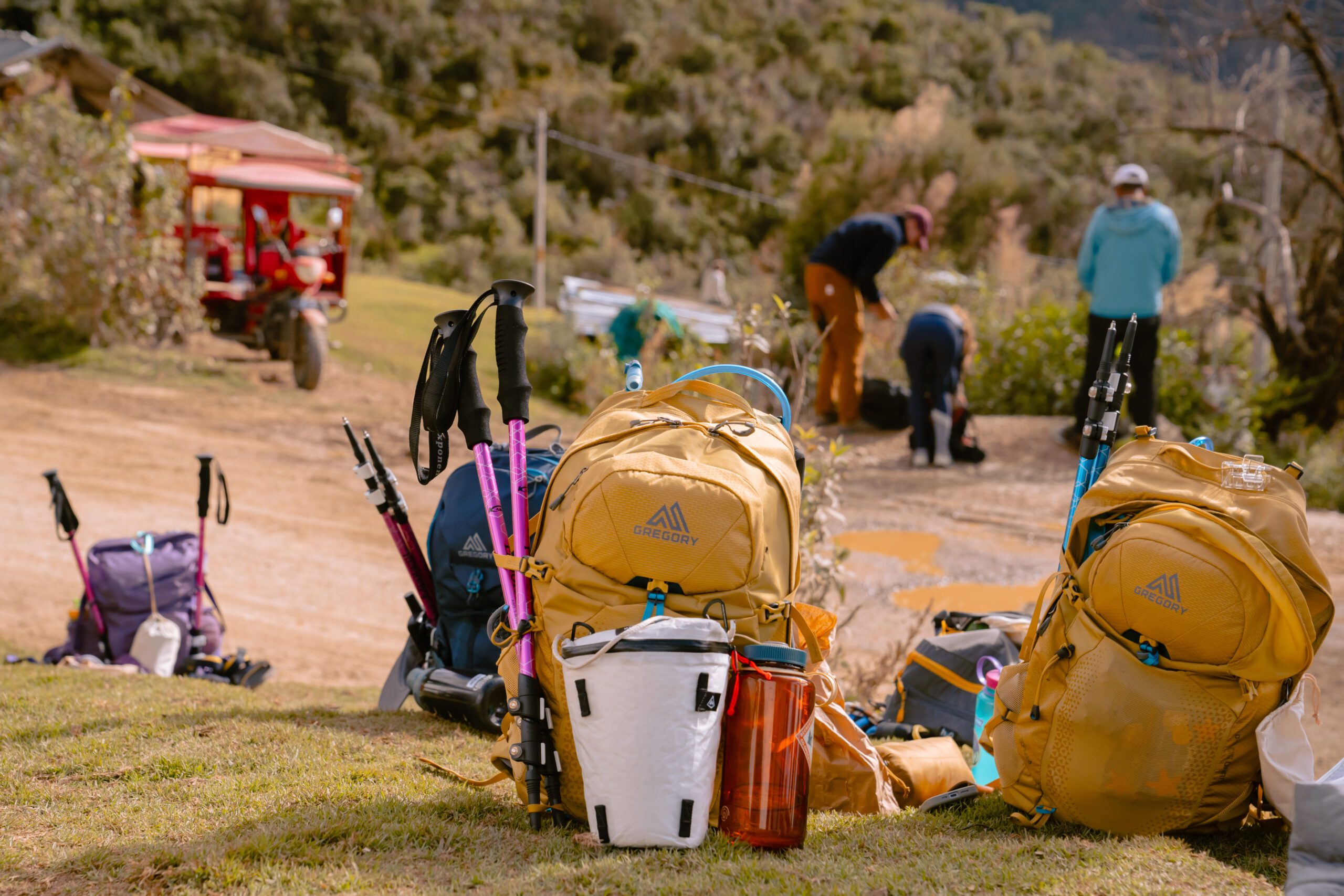My latest group hiking trip was the 5-Day Hut to Hut Salkantay Trek in Peru.
I’m going to share with you my full & complete packing list for my May 2024 trip including the one item I regret not bringing & the one item I’ve since purchased, but would have loved to have brought on the trek!
While we didn’t need to carry EVERYTHING for the 5 day hike, we did have to be strategic & limited with what we could bring.
We carried a day pack with what we needed for the day on the trail & were issued a 40L duffle by our guide company, Salkantay Trekking, that needed to fit everything else.

Which is honestly pretty easy if you pack smart & only bring what you need.
That duffle would get transported for us from hut to hut & be there by the time we arrived.
Having done multiple hut to hut treks at this point – like my first group hiking trip of the Laugavegur Trail in Iceland (also 5 days & around 50 miles) & a few multi-day hikes to the Appalachian Mountain Club huts in the New Hampshire White Mountains – I really feel like I have my packing list pretty dialed.
(Read this blog post – Trip Guide: 5-Day Hut to Hut Salkantay Trek in Peru).
This is the packing list I shared with my group & I hope this helps you plan an epic Salkantay Trek of your own!
FYI: I own almost every item on this list, have trail tested them, & also personally brought them on the Salkantay Trek in Peru.
There was one item, however, I regret NOT bringing.
And one other item that wasn’t 100% necessary, but that I’ve since purchased & would have loved to have it on the trek.
More on those below…

Packing List: 5-Day Hut-to-Hut Salkantay Trek in Peru
30L Hiking Backpack, Hydration Bladder, & Pack Rain Cover
CODE MEREDITHEWENSON15 FOR 15% OFF GREGORY MOUNTAIN PRODUCTS
- Gregory Juno 30 H20 (comes with a Hydration Bladder, I used this pack hiking in Iceland & Peru)
- Gregory Jade 28 (does NOT come with a Hydration Bladder, you’ll need to buy one separately)
- Gregory Maya 30 (does NOT come with a Hydration Bladder, you’ll need to buy one separately)
- Gregory 3D Hydro 3L Reservoir
- Gregory 30L Pack Cover
Waterproof or Gore-Tex Hiking Boots
Even though we did the Salkantay Trek in the dry season, it’s still recommended to wear waterproof hiking boots because the weather can change at any time (& we did get a tiny bit of rain at one point!).
(If you want my full review on these hiking boots & why I choose Gore-tex, read that blog post here.)
Wool Socks
My recommendation: 1 pair per day of hiking + 1 pair that’s exclusively for when you get to the huts & for sleeping each night. The hut pair won’t really get dirty, so one total for the huts is fine in my opinion.
Hut Shoes
Probably a sandal, or something lightweight that you can wear with socks around the huts at night so your feet are comfortable & warm. Trust me, you’ll want to take your hiking boots off as soon as you get to camp.
Wool Long Sleeve
My recommendation: 1 of these unless you know the weather will be colder.
The first couple days/night on the Salkantay Trek are at higher altitude (13-15k feet) so it’s a good idea to have at least one warmer wool layer.
Synthetic Wicking Long Sleeves
My recommendation: 3-5 shirts. I generally wear a shirt more than once, but totally your preference.
On day 2 after the Salkantay Pass, you’ll drop in elevation signifigantly (nearly 6k feet) into the jungle where it can be hot & humid. This is where I prefer lightweight synthetic long sleeves with a hood to keep cool & covered from the sun.
- Mountain Hardwear Crater Lake Hoodie
- REI Co-op Sahara Shade Hoodie
- Patagonia Capilene Cool Daily Hoodie
Midweight Fleece
This can also double as an extra layer for around camp or at night to bed.
Midweight Puffer Jacket
I live in a puffer jacket. I wear it on the trail, at camp, & even to sleep if it’s cold. Personally, I don’t travel or hike without one, ever!
- Rab Microlight Alpine Down Jacket (I have this one)
- Patagonia Down Sweater Hoodie
Hiking Pants / Leggings
My recommendation: I generally wear pants more than once, so on a 5-day trek, I’d bring 2-3.
Shorts are NOT recommended on the Salkantay Trek because of bugs, brush, & there’s also a lot of horse poop on the trails. Personally I was happy my legs were covered.
Whether to wear leggings or hiking pants is totally personal preference. For long hiking days I often prefer hiking pants. If I do a legging, though, I like to have a thigh pocket on the side for my phone.
- Vuori Stride Leggings
- REI Co-op Trailmade Pants (my new favorite hiking pants)
Hut Outfit
My recommendation: 1 pant + 1-2 shirts.
I like to reserve one outfit that is for “hut only”. This is likely one additional pair of light cozy pants, an additional longsleeve, & maybe a tank top in case it’s hot.
These can be cotton & don’t have to be “technical” (which is nice), but I will sometimes pack what CAN be worn hiking in a pinch in case all my other gear gets super gross or wet. If I’m traveling extra light I might purposely plan to wear it as a fairly fresh hiking outfit for the last day, or make my hut outfit whatever I plan to sleep in.
Rain Jacket
Make sure you get a rain jacket that is waterproof, not a “windbreaker”.
Any rain jacket that is Gore-Tex will be even more durable & waterproof (but also more expensive).
- Patagonia Torrentshell 3L Jacket (Waterproof)
- Patagonia Granite Crest Jacket (Waterproof – I have this one)
- REI Co-op Rainier Rain Jacket (Waterproof)
- REI Co-op XeroDry GTX Jacket (Gore-Tex)
Rain Pants
Again make sure they are rain pants that are waterproof, not “windbreaker” pants.
Even if you’re not trekking in the rainy season, I’d bring these. They take up almost no space, are super light, & can add an extra layer of warmth if you need it. It’s better to be safe than sorry.
- REI Co-op Rainier Rain Pants (Waterproof, these come in regular, petite, tall, & plus sizes – I have these)
- REI Co-op XeroDry GTX Pants (Gore-Tex, these come in regular, petite, tall, & plus sizes)
Winter Beanie
No matter the season, it’s always great to have a beanie. I often sleep in mine on hiking trips if it’s cold at night!
Sun / Baseball Hat
Both of these hats are lightweight & dry quick which is great for rain or sweat.
Lightweight Gloves / Mittens
No matter the season, I pack these.
They are my go-to for any active outdoor activities from XC skiing to hiking.
I also bring Gore-tex mitten shells just in case. They weigh almost nothing & could really save you if you get wind, rain, or snow when hiking 10-12 hour days, at altitude.
(Keep in mind: When you’re using trekking poles, you can’t put your hands in your pockets to keep them warm & dry, so dry gloves can be a lifesaver).
While I did the Saklantay Trek in the dry season, we did actually get some rain for a short period of time. For those who opted to do the extra hike to Humantay Lake, it downpoured. I unfortunately had altitude issues so I was resting in my hut instead, but I would have been wearing both my mittens & the Gore-tex mitten shells on that side hike if I went!
(The Gore-Tex mitten shells were the ONE thing I didn’t bring on my Laugavegur Trek in Iceland last September that I wish I had!)
- Smartwool Active Fleece Wind Mittens
- Smartwool Active Fleece Gloves
- REI Co-op Minimalist Mittens 2.0
Neck Buff
These can be used for sun, wind, or dust. The wool version will be a bit warmer, but if you anticipate actual cold weather, I’d also bring a fleece one.
Sleep Layers
My recommendation: 1 sleep set (top & bottom).
I personally like to camp/cabin/hut sleep in merino wool baselayers. Wool can keep you warm (with more layers, if needed) or cool (keeps sweat off your skin) if it’s hot.
And I see no reason to bring more than one set for a 5-day trek.
- REI Co-op Merino 185 Base Layer Bottoms (Lightweight)
- REI Co-op Merino 185 Long-Sleeve Base Layer Top (Lightweight)
- Smartwool Classic All-Season Merino Long-Sleeve Base Layer Top (Lightweight)
- Smartwool Classic All-Season Merino Base Layer Bottoms (Lightweight)
- Smartwool Classic Thermal Merino Crew Base Layer Top (Midweight)
- Smartwool Classic Thermal Merino Base Layer Bottoms (Midweight)
Water Bottle
I don’t hike with the 32 oz water bottle becaue I prefer a hydration bladder, but I like to have it at camp & as a backup in case my hydration bladder leaks or breaks.
I like to use the 16 oz for my electrolytes & AG1 daily greens powder because I don’t like to put those in my everyday Nalgene or hydration bladder.
- 32 oz. REI Co-op Nalgene Sustain Graphic Wide-Mouth Water Bottle
- 16 oz. REI Co-op Nalgene Sustain Graphic Wide-Mouth Water Bottle
Sunglasses
Goodr are my favorite because they’re super lightweight, affordable, don’t slip, & fit my smaller face. This is the style I have, but they’re all cute!
Headlamp
You’ll defintely want a headlamp for middle of the night trips to the bathroom & getting around camp after dark.
Power Bank Charger
We DID have access to electrical outlets each night on the trek, but honestly I would assume that you might not (or that they may not work).
Capacity of the power bank will all depend on how much you plan to charge (or not) during the trek. If you plan to bring a camera or any other gear beyond just a cell phone, you might need a power bank on the larger side.
- Goal Zero Flip 36 Power Bank (This has got my cell phone through 3 days of backpacking using it for photos & video only)
- Anker Power Bank (This one will get my cell phone up to 5 days, I’ve also used it to charge my Sony Camera)
Travel Towel
A couple of the huts have showers, but don’t supply towels.
Camping Pillow (optional)
The huts did have pillows, but I personally like to additionally use mine inside my sleeping bag. It can also double as an airplane pillow.
Sleeping Bag (renting is recommended)
Most people on my trip opted to rent theirs from our guide company, Salkantay Trekking. If you don’t already have a sleeping bag you own & love, honestly, I’d go that route if your guide company offers it. They were high quality & clean.
If you DO want to bring yourn own, make sure it’s rated at least 30 degree F for the Salkantay Trek.
While sleeping bags are definitely a personal preference, this is the one I have & LOVE it. It’s so light, comfortable, & warm.
I also love that it now comes in a variety of sizes – short, long, narrow, wide, etc.
This sleeping bag is made of down which is lighter, but also a bit pricier.
- REI Co-op Magma 15 Sleeping Bag (I have this one)
- REI Co-op Magma 30 Sleeping Bag
Compression Sack for Sleeping Bag
If you plan to bring your own sleeping bag, I’d recommend a compression sack in order to maximize the amount of space in your luggage.
And I personally have this waterproof “dry bag” version so it also keeps my sleeping bag dry should my duffle get wet (the duffles provided by Salkantay Trekking that we had to use were not waterproof & were transported by horse)
Trekking Poles (renting is recommended)
I personally rented these from our guide company & would recommend that for anyone doing this as a guided trek.
If you DO plan to bring your own trekking poles, keep in mind that you cannot put them in your carry-on luggage.
I recommend doing carry-on only as not to potentially lose your luggage before your trek. If you do choose to check a bag though & want to bring your own, these are the trekking poles I own.
Toiletries
I’d recommend being really minimal on the trail & bringing as few liquids that can explode or leak as possible. Face & body wipes will be your friend.
CODE EWENSON20 FOR 20% OFF URSA MAJOR
CODE MEREDITHE15 FOR 15% OFF KINFIELD
- Sea to Summit Wilderness Wipes (I personally opt for this type of “shower” most of the time)
- Ursa Major Essential Face Wipes (these are actually both really cleansing & hydrating)
- Aurelle TOOB Brush (so compact!)
- Face SPF
- SPF Lip Balm
- Bug Spray
- Hand Sanitizer
- Moisturizer
- Shampoo & Conditioner
- Feminine Hygiene
- Hair Elastics
Personal First Aid
The item I DIDN’T bring (& really regretted not having) was Diamox, the prescription medication for preventing or lessening the symptoms of altitude sickness.
Going from 0 feet at sea level in Rhode Island to 11,152 feet landing in Cusco, then as high as 15,190 feet at the Salkantay Pass while on the trek was… a lot.
Even with 2 days of acclimation in Cusco, I struggled once we were at 13k-15k feet.
Despite training specifically for hiking & altitude, there’s only so much you can do if you’re coming from sea level & have potentially have a propencity for issues at high altitude.
As someone who doesn’t normally take medication at all, I’d 100% recommend taking this before/during your trip as directed.
- Personal Medication
- Headache Medication (over the counter – common altituide symptom)
- Neausea Medication (over the counter – common altituide symptom)
- Diamox (Perscription)
- Band-aids
- Blister Pads
- Ignik Hand Warmers (A good idea to have in your daypack just in case it’s cold & Night 1 at the highest altitude where the temps will be the coldest & might want them in your sleeping bag)
Dry Bags + Packing Cubes
I love using small Dry Bags to separate, keep things dry, &/or keep spills from getting on other stuff.
Bigger dry bags can be used to separate smelly or wet gear, for snacks, or just to keep things organized.
- Sea to Summit Lightweight Dry Bag (1.5L is good for things like your phone/electronics)
- Sea to Summit Ultra-Sil Dry Bag (3L size is good for things like toiletries & it’s conveneint to be able to hang it on a hook or door handle)
Compressable packing cubes are also a really helpful idea in your luggage to not only keep things separate, but also maximize as much space as you can.
Camera
Obviously cameras are a totally personal choice, but here’s what I have & brought on the Salkantay Trek. And would bring this setup again!
- Sony A7iii Full Frame Mirrorless Camera
- Sigma 24-70mm f2.8 Lens
- Peak Design Capture 3.0 Camera Clip (to keep camera accessible on my day pack)
- Hyperlite Camera Pod, size Large (for when it’s in my bag, the material is slightly padded & water resistant. I can also rig it up to hang on my chest which I’ve done in winter or if there’s rain)
Smart Watch
The one item I didn’t bring that I’ve since purchased & would have LIKED to have on the trip, is a smartwatch specific for physical activity so I could track our route, mileage, altitude, heart rate, & even oxygen saturation.
After a lot of research I went with this Garmin model as the best choice for hiking.
And because I know someone will ask, I went with Garmin over Apple Watch since Apple doesn’t nearly offer the same capabilities & has a much shorter battery life.
- Garmin fenix 7S Pro Sapphire Solar Edition (S refers to the smaller face, there are larger options too)
Miscellaneous
- Sports Bras & Underwear
- Bathing Suit (if you plan to stop at the hot springs)
- NUUN Sport Hydration Tablets
- Bars / Snacks
- Charging Adaptor for Peru (Type A & B)
- Charging cords for phone, camera, etc
- Ear Plugs
- Eye Mask
- Passport + copy of Passport (you need your Passport to get into Machu Picchu)
- Cash & Soles (for paying to use bathrooms on trail, tips, snacks, etc)

Are you planning to do the Salkantay Trek in Peru? Read this blog post – Trip Guide: 5-Day Hut-to-Hut Salkantay Trek in Peru.
This blog post may contain affiliate links which earn me a small commission, but at no cost to you. This is a small way you can support & I appreciate it!
Photo credits: Dasha Afanaseva




+ show Comments
- Hide Comments
add a comment